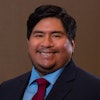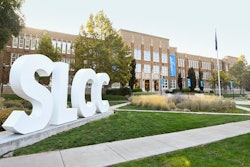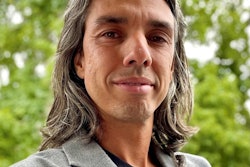The University of New Mexico has rejected a sculpture it had commissioned from a Native-American artist because his final product includes barbed wire.
The work, “Cultural Crossroads,” by Bob Haozous, “is not the work we commissioned,” says Bob Walsh, director of UNM’s Pine Arts Museum. “It is substantially different.” The model that Haozous presented is different from the final product, says Walsh. And while a number of changes were made from the original model, it is one change, in particular, that has raised the ire of the university — the razor wire that sits atop the work.
The sculpture depicts a migration scene from an old Aztec picture book. Three Indians are shown migrating toward Albuquerque in the United States. According to Haozous, the work depicts a border crossing.
“Everything in the work is a symbol,” says Haozous, explaining that the full title of the work is called “Cultural Crossroads of the Americas.” The barbed wire, which appears both in his work and along the U.S.-Mexico border, “is a dehumanizing part of our lives…. It’s tremendous symbolism.” As to why it was not part of the original model, he says: “The work matured in the studio.”
Censorship or Contractual Obligations At the moment, the university is withholding payment to Haozous and is attempting to get the artist to remove the wire from the work. One of the other alternatives is to remove the sculpture altogether from the university grounds, says Walsh, who insists that the issue is not about censorship but about contractual obligations.
“It depends on your point of view, and I admit there are other points of view,” concedes Walsh. If the barbed wire remains, it would both subvert the process and be unfair to the other artists who submitted their works, he says, because they participated in a competitive process.
“The piece he delivered may be better than the one he proposed, but we really want that piece [that was approved]. The one he delivered is significantly different,” complains Walsh. The issue, says Walsh, is about respecting the integrity of the process. More than 200 people from the public approved the model. “Next time, when we ask people to help us choose, they will wonder: ‘why should I bother to vote?’ It encourages cynicism.”
“We know art is controversial,” adds Walsh. “I love his work because it is controversial. The wire gives it a different bite and meaning.”
Haozous believes the controversy is not about the process, but rather about the message. People object to the fact that it’s not decorative art — not the kind of art that whites have become accustomed to seeing or that they have come to expect from Native Americans, says Haozous. “They don’t want to see the holocaust against brown people, about what they’re doing to them on the border,” accuses Haozous.
Public Discussion Proposed
The commissioned work is actually a joint venture between the city and the university. Jane Sprague, assistant coordinator for the city’s public art program, says the city found the work to be acceptable. The city’s art board, she says, found the work to be a “social, cultural and political commentary, within the context of what he [Haozous] proposed. It was his type of art work and the board found it acceptable.” Sprague says there is no precedent for handling such a dispute when the city approves and the university disapproves of a piece of art. She notes that the sculpture is on university property and that UNM has committed more money to the project. The city’s portion is $15.000 and UNM’s is $65,000.
Sprague says that the city’s art board believes it is important to have a public discussion so that the campus and surrounding community can address the issue. The Native American Kiva club at UNM, the Albuquerque Arts Alliance, and the Washington, D.C.-based Morning Star Foundation — a Native American civil rights organization — have also suggested having a public forum to dead with the issue.
Walsh agrees that a forum is appropriate and says that its purpose should not be a referendum, but “a way to allow different people a chance to talk and listen. To think it over. Maybe it will I reveal if something is fundamentally flawed with how we are dealing with each other. It’s a terrible situation.”
However, Haozous says he doesn’t know what the purpose of the forum would he. To him, the issue is quite simple: creative expression versus censorship. When dealing with issues such as censorship, there is no place for a compromise, he says.
Putting It to a Vote
Walsh says that as soon as the work was delivered, members of a joint ad-hoc University of New Mexico/Public Arts Committee were up?set. A meeting was convened shortly thereafter and the committee voted unanimously to reject the work. Sprague says three e other members were not present and have indicated that they we would have voted in favor of it. Ted Jojola, a professor in the school of architecture and planning, a member of the joint committee and former director of Native American studies, says the vote was fraudulent. In a letter to Gordon Church, coordinator of the Albuquerque Public Arts Program, Jojola states:
“It is my conviction that the c committee vote is fraudulent, as it was obtained without due process As a voting member, I had only been notified verbally that a meeting was being convened to discuss the merits of the issue. Because of teaching conflicts I was unable to attend and was consequently requested to communicate my opinion to your office (which I did by telephone on the morning of September 25th). I was not, however, notified that a formal vote would be conducted by the members in attendance nor was I offered a proxy vote in the event of a legitimate conflict.
“Based on this violation, I am requesting that the Albuquerque Public Arts Program dismiss the Committee’s vote, without prejudice, from its deliberation. Failure to do so may result in litigation, particularly if Mr. Bob Haozous is required to compromise or remove his sculpture.”
Jojola says he became aware after writing the letter that the committee he was serving on was merely an advisory committee. Walsh confirms that the committee is advisory and admits that the worst-case scenario is litigation.
Jojola says that despite his advisory capacity, he believes the determination of the committee “represents the skewed view of a ‘privileged voice’ end an isolated minority on campus.”
Jojola further states that the notion of having to get further public input “reminds me of those neo-colonial fascists who made binding treaties with Indians and then reneged in the face of their non-ratification at the Congressional level.” Haozous says: “I gave them the best piece I’ve ever done. They want to hide things in the closet, but compare the borders with Canada and Mexico,” he says. The disparate treatment on the borders shouldn’t be allowed to happen, he says. But it happens, he adds, because the people coming across the Canadian-U.S. border are white whereas those coming across the U.S.-Mexico border are brown.
Walsh says that the other changes are understandable and permissible. One involved replacing a star with an ‘end of the trail’ cowboy. Also, a horse was replaced by three rings, which Walsh says probably represents the old Mayan ball games. “Those are allowable. However, the wire on top is totally a new element. It goes contrary to the spirit and letter of the contract. It’s not just a legal document. It’s a social contract.”
Haozous says he is convinced that the issue has to do with preconceptions about Native American art. “They want art that is quaint,” he says. “I want to make an honest statement.”
In the meantime, Haozous says, “Everybody’s talking and I’m hungry.”
COPYRIGHT 1996 Cox, Matthews & Associates
© Copyright 2005 by DiverseEducation.com





















